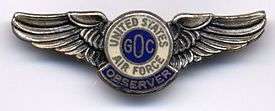Ground Observer Corps
The Ground Observer Corps (GOC), sometimes erroneously referred to as the Ground Observation Corps, was the name of two American civil defense organizations during the middle 20th century.
World War II Organization
The first Ground Observer Corps was a World War II Civil Defense program of the United States Army Air Forces to protect United States territory against air attack. The 1.5 million civilian observers at 14,000 coastal observation posts performed naked eye and binocular searches to detect German or Japanese aircraft. Observations were telephoned to filter centers, which in turn forwarded authenticated reports to the Aircraft Warning Service, which also received reports from Army radar stations. The program ended in 1944.[1] A few Aircraft Warning Service Observation Towers survive as relics.
Cold War Organization


The second Ground Observer Corps,[2] with programmatic aims and methodologies similar to the first, was organized in early 1950, during the Cold War. Operating as an arm of the United States Air Force Civil Defense service, the second GOC supplemented the Lashup Radar Network and the Permanent System radar stations.[3] Observations were telephoned directly to filter centers[2][4] and the information was in turn relayed to Air Defense Command ground control interception centers.[5] By 1952 the GOC program was expanded into Operation Skywatch, consisting of 750,000 volunteers aged 7 to 86 years old working in shifts at over 16,000 posts and 73 filter centers.[6][7] Extant examples of observation platforms used by GOC/Skywatch volunteers include the Cairo Skywatch Tower;[8] another tower exists in Soda Springs, Idaho.[9]
The second GOC program ended in 1958[10] with the advent of automated Army (Missile Master) and Air Force (SAGE) radar systems. GOC volunteers were encouraged to continue their service in the Radio Amateur Civil Emergency Service (RACES).

Popular culture
The GOC was a story element in the 1957 science fiction film The Deadly Mantis.
|
|
See also
References
- ↑ Morgan, Mark L; Berhow, Mark A (2002). Rings of Supersonic Steel (Google Books) (second ed.). Hole in the Head Press. ISBN 0-615-12012-1. Retrieved 2011-09-13.
- 1 2 "Less Than Half Spotter Time Filled In Week" (Google News Archive). The Gettysburg Times. Times and News Publishing Company. April 5, 1954. Retrieved 2012-01-04.
- ↑ Winkler, David F (1997). Searching the skies: the legacy of the United States Cold War defense radar program. Prepared for United States Air Force Headquarters Air Combat Command.
- ↑ "News of Southington". Meriden Record. Meriden, Connecticut. 22 February 1954.
The meeting will be addressed by Lieut. Wenzel of the New Haven Filter Center,...
- ↑ Schaffel, Kenneth (1991). The Emerging Shield: The Air Force and the Evolution of Continental Air Defense, 1945–1960. Washington, DC: Office of Air Force History. Archived from the original on 2005-11-13.
- ↑ "Before decent radar, the U.S. enlisted 800,000 children, hobbyists, and other Americans as lookouts". www.timeline.com. Retrieved September 11, 2017.
- ↑ "The Ground Observed Corps". radomes.org. Retrieved 2017-06-12.
- ↑ "Indiana State Historic Architectural and Archaeological Research Database (SHAARD)" (Searchable database). Department of Natural Resources, Division of Historic Preservation and Archaeology. Retrieved 2016-07-01. Note: This includes John M. Harris; Angela Bowen; Ben Ross (July 2001). "National Register of Historic Places Inventory Nomination Form: Cairo Skywatch Tower" (PDF). Retrieved 2016-07-01. and Accompanying photographs
- ↑ "Ground Observation Corps Soda Springs Post Historical Marker". The Historical Marker Database (HMdb.org). J. J. Prats. Retrieved October 31, 2017.
- ↑ "Filter Center 'In Reserve'". The Milwaukee Sentinel. Milwaukee, Wisconsin. 1 January 1958.